Covid 19 Airborne Risk Measuring in a Classroom
$120.00 Student Discount
- The problem numerically simulates Covid 19 Airborne Risk Measuring in a Classroom using ANSYS Fluent software.
- We design the 3-D model by the Design Modeler software.
- We Mesh the model by ANSYS Meshing software, and the element number equals 2745511.
- We perform this simulation as unsteady (Transient).
- We use the Discrete Phase Model (DPM) to define virus particle injection.
- We aim to investigate the effectiveness of the ventilation system in the classroom for cleaning the air.
To Order Your Project or benefit from a CFD consultation, contact our experts via email ([email protected]), online support tab, or WhatsApp at +44 7443 197273.
There are some Free Products to check our service quality.
If you want the training video in another language instead of English, ask it via [email protected] after you buy the product.
Description
Covid 19 Airborne Risk Measuring in a Classroom, ANSYS Fluent CFD Simulation Training
This simulation is about covid 19 airborne risk measuring in a classroom via ANSYS Fluent software. We perform this CFD project and investigate it by CFD analysis.
Corona (COVID-19) is currently recognized as the most significant human challenge globally; Because this virus, in addition to being dangerous to human health, has a high transmission power between sick people and healthy people.
The breathing of a patient without a mask in a closed public environment transmits the virus to their neighbors. One of the doctors’ critical recommendations regarding preventing virus transmission is maintaining a proper social distance between people in such places.
For example, a short distance between a university student seat or a schoolboy in a classroom can increase the risk of transmitting COVID-19 disease from a patient to other people nearby.
This project simulates the breath of viral air from the mouth of sick coronavirus-carrier students in the classroom. This project aims to investigate the effectiveness of the ventilation system installed in the classroom in eliminating polluted air and cleaning the air.
In this project, a ventilation system has been used, with several vents for the entry of fresh air flow from the ceiling of the classroom and several panels for the exit of the old airflow at the bottom of the classroom’s sidewalls.
The geometry of the present model is drawn by Design Modeler software. This model includes a computational zone in the form of a classroom and chairs inside which a student is modeled on each of the chairs. For each student, a surface is defined as the mouth’s source for breathing and virus transmission.
The model is then meshed by ANSYS Meshing software. The model mesh is unstructured, and 2745511 cells have been created.
Covid 19 Method
For the present simulation, the discrete phase model (DPM) is used; Because this model allows us to study a mass of particles discretely in a continuous fluid (air). The discrete phase corresponding to the virus particles is defined in the steady-state solver.
After activating the discrete phase model, the injection process must be defined, determining the type and quality of discrete particles injected into the classroom.
In this model, the virus particles are defined as inert particles, and the injection type is surface and through the inner surface of the mouth of each student (mouth).
The discrete phase model’s boundary conditions are defined in the classroom with Escape mode, meaning that the particles pass through these boundaries. All the people and the body of the chairs and the classroom’s side walls have a Trap mode, which means that particles are trapped and accumulate in these borders.
Covid 19 Conclusion
After simulation, particle tracking of the virus particles is obtained based on the residence time of 60 s. Also, 2D and 3D contours related to temperature and air velocity inside the classroom have been obtained. The flow path lines are also obtained in 3D.
The results show that this ventilation system is inappropriate for the classroom and increases the risk of virus dispersion. This is because the virus particles spread completely in the classroom’s interior. In other words, the classroom ventilation system’s mechanism helps the virus survive in space.

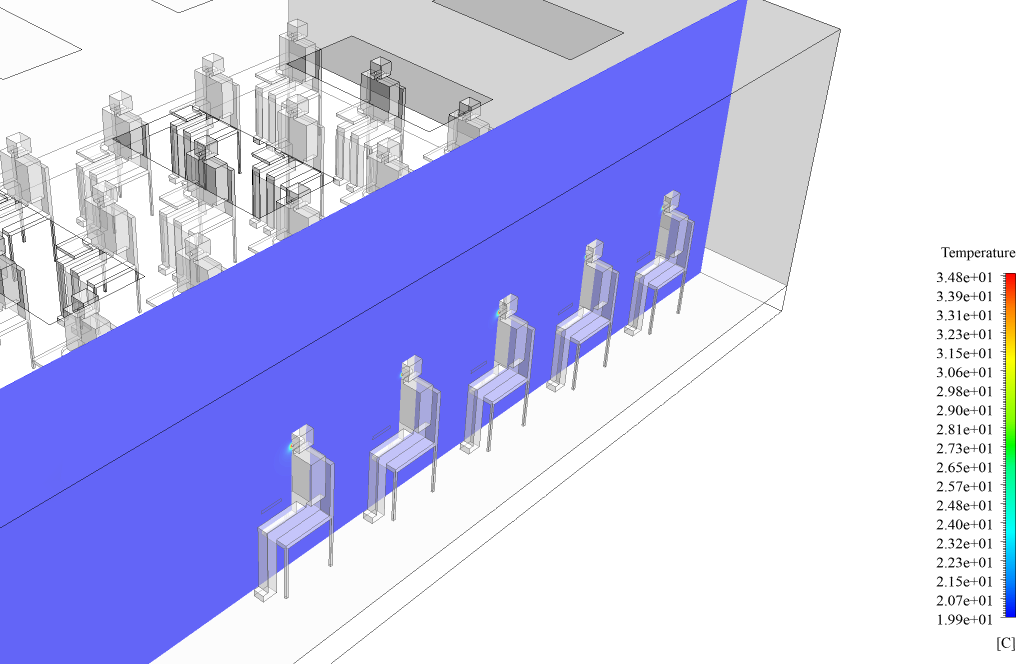
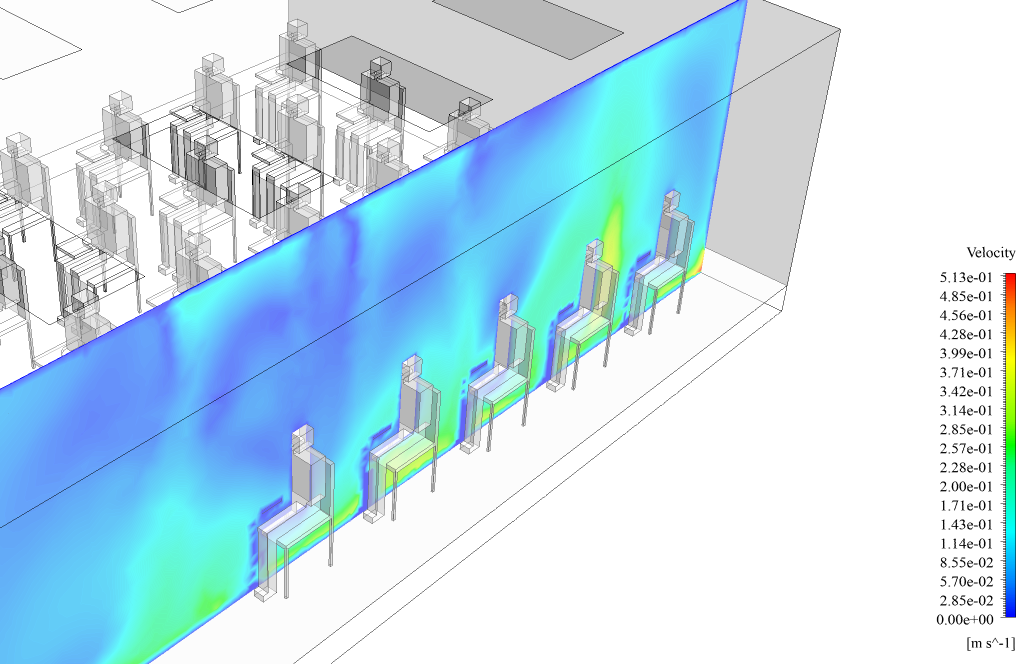
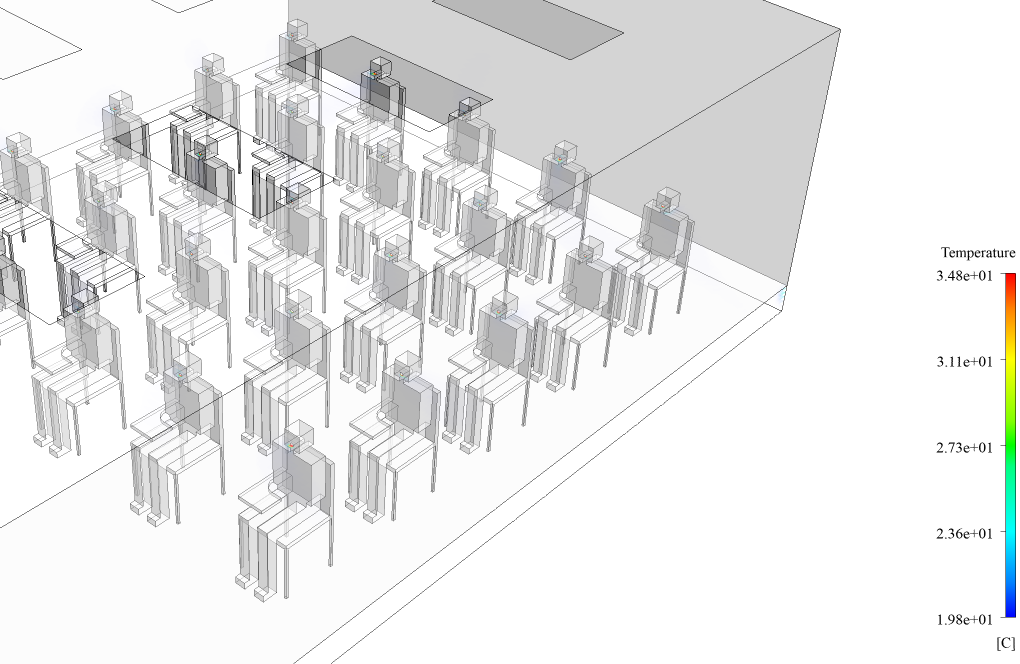
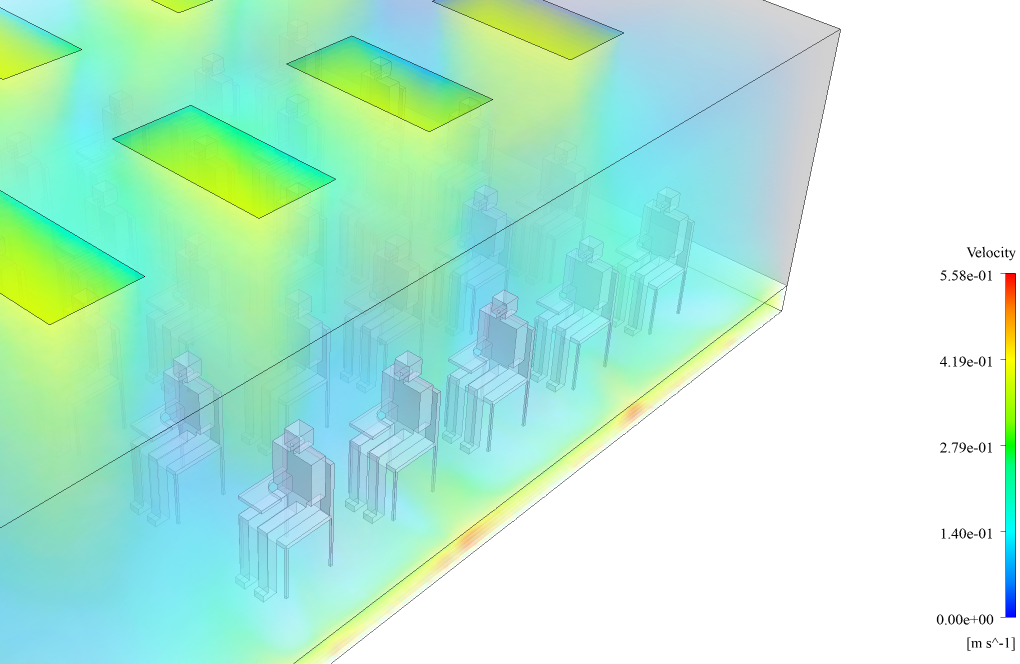
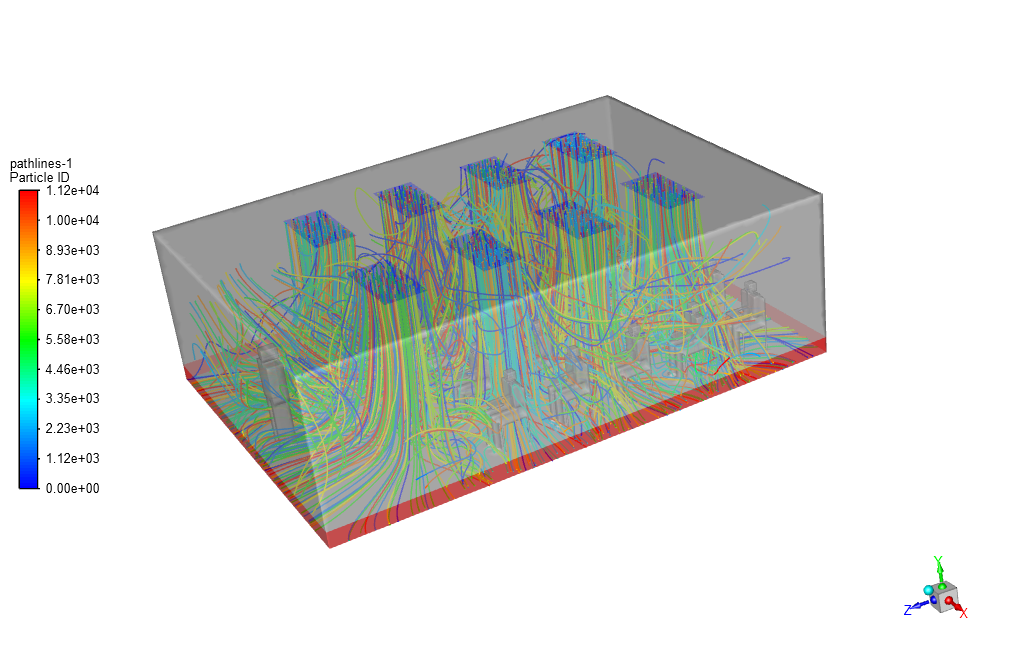
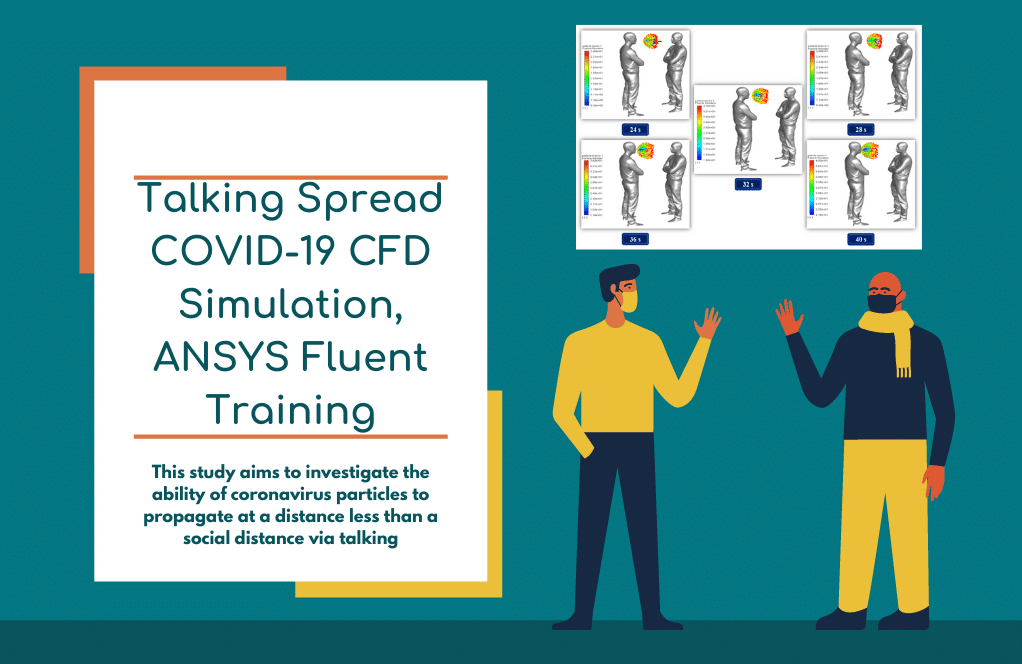


Dr. Mattie McDermott I –
Is it possible to adjust the ventilation system in this simulation?
MR CFD Support –
In this particular simulation, modifying the ventilation system would require setting different boundary conditions or parameters for the inflow and outflow vents to help minimize the risk of virus dispersion. Changes in the ventilation design could then be tested for effectiveness using the simulation.
Santa Stokes –
I was thoroughly impressed with the Covid-19 Airborne Risk simulation for classrooms. The detail and practical application are spot on for current times.
MR CFD Support –
Thank you for your positive feedback! We’re glad our simulation met your expectations and provided insights applicable to today’s circumstances. Your appreciation encourages us to continue delivering high-quality CFD simulations.
Miss Angelica Batz Jr. –
Is there a particular reason why the virus particles are defined as inert in the simulation? Does this affect the accuracy of the airflow risk assessment?
MR CFD Support –
Inert particles in the simulation refer to the assumption that the virus particles do not undergo any chemical reaction or phase change within the given environment. It helps in simplifying the model and focusing on the airflow and droplet movement patterns, which are critical in airborne transmission risk assessment. While defining the particles as inert may not account for certain conditions that affect viability, it still provides valuable insights into the dispersion and concentration of particulates, which is crucial for assessing the risk of airborne Covid-19 exposure in the classroom scenario.
Jacky Kulas –
I was impressed with the degree of detail in your Covid 19 Airborne Risk simulation in a classroom. Has this study been compared with real-life data to validate the model accuracy?
MR CFD Support –
Thank you for your compliment and question. There isn’t specific information provided on whether this study has been directly compared with real-life data. Validation often involves experimental comparisons which is a crucial step to ensure simulation results are accurate. If such a validation process was performed, this would offer further confidence in the project’s conclusions.
Rosemary Kessler –
What measures can be taken to improve the ventilation system in the classroom based on the simulation findings?
MR CFD Support –
Based on the simulation findings, several measures can be considered to improve the classroom’s ventilation system. These may include increasing airflow rate, altering air inlet and outlet positions, employing high-efficiency air filters, or even integrating localized exhaust systems near the source of virus transmission to enhance virus particle removal from the air.
Ms. Sandy Hettinger –
The provided analysis of airborne risks in classrooms under COVID-19 conditions is highly detailed and informative. In particular, the utilization of the DPM model to assess virus particle distribution and the evaluation of the ineffective ventilation system deliver compelling results that echo the importance of efficient air management—with public health implications well beyond the classroom. The rigorous CFD approach taken here offers valuable insights for both educational institutions and health policymakers.
MR CFD Support –
We truly appreciate your thoughtful review of our Covid 19 Airborne Risk Measuring CFD Simulation Training product. It is gratifying to know that our efforts to provide thorough and detailed analysis using ANSYS Fluent have been beneficial and that the insights gained could make a genuine impact in real world scenarios. Thank you for your support and recognition of the importance of such simulations in guiding effective health and safety decisions.
Prof. Pablo Schmitt Jr. –
Can the results from this simulation help improve the design of classroom ventilation systems to reduce transmission risks?
MR CFD Support –
Yes, this simulation provides insight into how airborne particles behave within the classroom environment based on the current ventilation system design. By analyzing the flow patterns and particle dispersion, design improvements can be made to enhance the ventilation system, which could help minimize the spread of viral particles and reduce the transmission risk.
Jean Grimes Sr. –
The results indicate the ventilation system wasn’t effective. Can you adjust the ventilation system in the simulation for improving the airflow and potentially lower the covid 19 transmission risk?
MR CFD Support –
Certainly, the simulation can be adjusted to test different ventilation system setups. Changing the positions and rates of airflow through the vents, altering the exhaust placement, or simulating different types of filters can help find a more effective layout that reduces the risk of airborne transmission in the classroom.
Antonio Turner –
I admired how this simulation not only visualizes the airflow but also virus particle spread, a potentially remarkable tool for improving indoor safety. Has this model been validated with empirical data from real-world scenarios?
MR CFD Support –
Thank you for your kind review! We strive to create simulations that serve practical purposes and aid public safety. Concerning validation, historically we compare our models against available empirical studies and standards. For specific cases like virus particle tracking, simulation scenarios are tuned to reflect known behavior based on virology studies and actual infected space statistics. However, intimate intricacies can vary, and detailed empirical comparisons are subject to available data.
Ada Schmitt –
Is there a suggested method mentioned for improving the classroom ventilation system to reduce virus particle spread based on the simulation results?
MR CFD Support –
The simulation indeed shows that the current ventilation system is not adequate for reducing the virus particle spread effectively. While no specific improvement methods are detailed in the summary provided, usually, simulations can help propose solutions such as increasing the air change rate, introducing HEPA filters, ultraviolet germicidal irradiation (UVGI), or modifying inlet and outlet placement. It might be beneficial if further studies are performed to determine a more effective ventilation strategy.
Eliza Kihn –
After refining the mesh, is there a significant change in the particle tracking that would suggest a better resolution of virus spread within the classroom?
MR CFD Support –
In CFD simulations like this, mesh refinement often leads to more accurate results by better capturing the details of flow and particle movement. Refining the mesh around key areas where virus particles are expected to disperse can potentially lead to a clearer picture of the spread within the classroom.
Ms. Otilia Reinger IV –
How effectively does the ventilation system remove contaminated air in the simulation and are there any improvements suggested in the study to mitigate airborne virus transmission in the classroom?
MR CFD Support –
The simulation results indicate that the current ventilation system in the classroom is not effective in removing contaminated air, as it allows virus particles to spread throughout the room. The study suggests reevaluating the airflow patterns and possibly repositioning the air vents and exhaust panels to create more directional airflow and enhance the removal of airborne contaminants, thus reducing the risk of virus transmission.
Erika Bailey –
This study is incredibly insightful! The rigorous investigation of air circulation and virus transmission risks in classroom settings can greatly help to devise better ventilation strategies to prevent the spread of diseases. Thank you for sharing the outcomes of the simulation, which emphasize the role of efficient air management in public health.
MR CFD Support –
We appreciate your positive feedback! It’s great to hear that our simulation on Covid-19 airborne risk assessment in a classroom setting has been valuable. Ensuring public health through proper ventilation and risk analysis is a priority, and we are glad that our CFD project could contribute to this important field. Thank you for recognizing the work. Stay tuned for more insightful studies!
Jayme Mante –
I just finished going through the COVID-19 Airborne Risk Measuring in a Classroom CFD simulation tutorial, and it was incredibly informative! I am very impressed with how well the simulation demonstrated the dispersion of virus particles in the classroom. The attention to detail, especially how the virus particles were modeled and the use of the DPM approach, were instrumental in understanding how airborne transmission occurs. The visualization of the particles and airflow patterns really helped me grasp the significance of ventilation in public spaces.
MR CFD Support –
Thank you so much for your kind words! We are thrilled to hear that you found the COVID-19 Airborne Risk Measuring in a Classroom simulation informative and that it provided valuable insights into the importance of ventilation. Understanding airborne transmission is critical, and we’re glad our tutorial could effectively demonstrate that. If you have any further questions or need assistance with other simulations, please let us know!
Ben Ferry –
Just wanted to say how fascinating I found this CFD simulation on Covid-19 risk in a classroom. The level of detail captured in the tracking of virus particles could be crucial in helping us design more effective, safe spaces for students in the future.
MR CFD Support –
We cannot thank you enough for your positive feedback. It is heartening to know our simulation can contribute to designing safer environmental spaces. Your encouragement fuels our commitment to using CFD in relevant and impactful ways. Stay safe!
Eldora Nolan DDS –
Could you explain how to interpret the DPM concentration results in relation to COVID-19 transmission risks?
MR CFD Support –
In interpreting DPM (Discrete Phase Model) concentration results, higher concentrations represent areas where virus-laden particles are more prevalent, implying a greater risk of COVID-19 transmission. The concentration data can highlight hotspots in the classroom where airborne viruses are likely to accumulate, helping assess the effectiveness of ventilation systems in dispersing these particles and lessening transmission risk.
Evert Swift –
Was there a specific airflow rate set for the classroom’s ventilation system in this simulation?
MR CFD Support –
In the simulation, the ventilation system settings include air vents on the ceiling for intake of fresh air at predefined flow rates, while the exit panels at the bottom of the sidewalls allow for the removal of air. The detailed airflow rates and the effectiveness of the ventilation system in dispersing the viral particles were key factors investigated in the CFD analysis to determine the system’s suitability.
Hope Beer –
Is it possible to adjust the ventilation system in the simulation to reduce the risk of virus dispersion?
MR CFD Support –
Yes, adjustments to the ventilation system parameters can be modeled within the simulation to evaluate their effectiveness at reducing virus dispersion. Optimization might involve changing the locations of vents, the flow rate of the air, or implementing HEPA filters to see if these changes can help in removing contaminated air more efficiently.